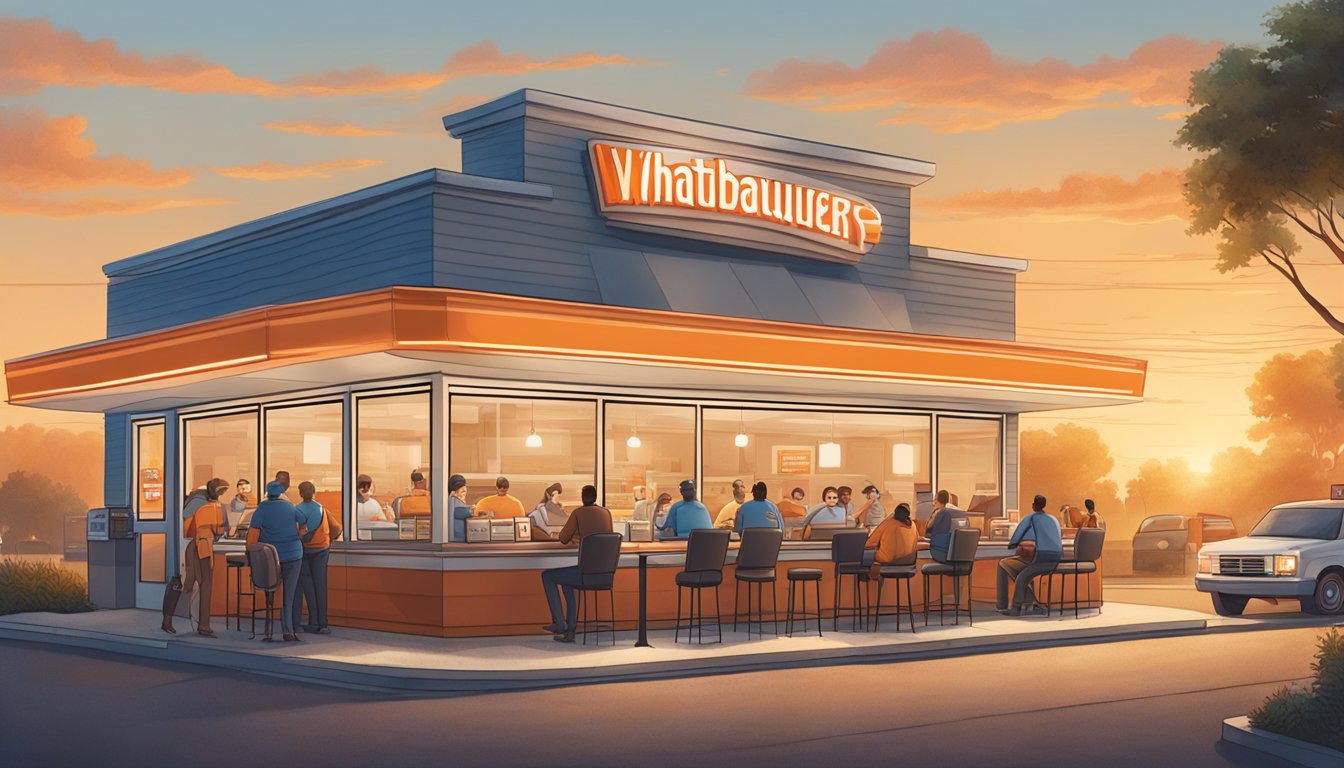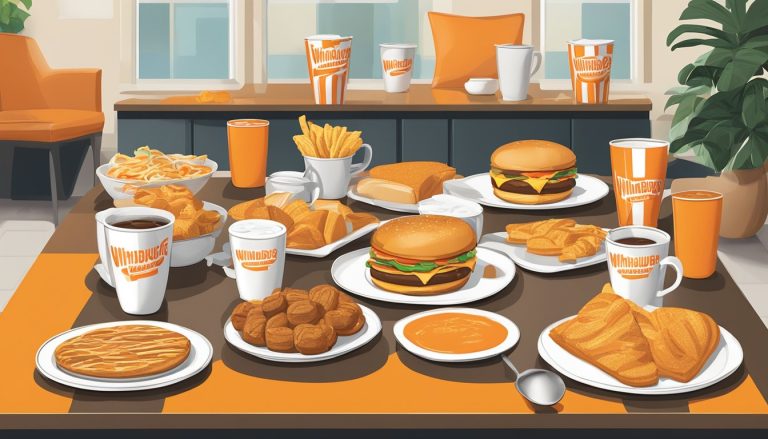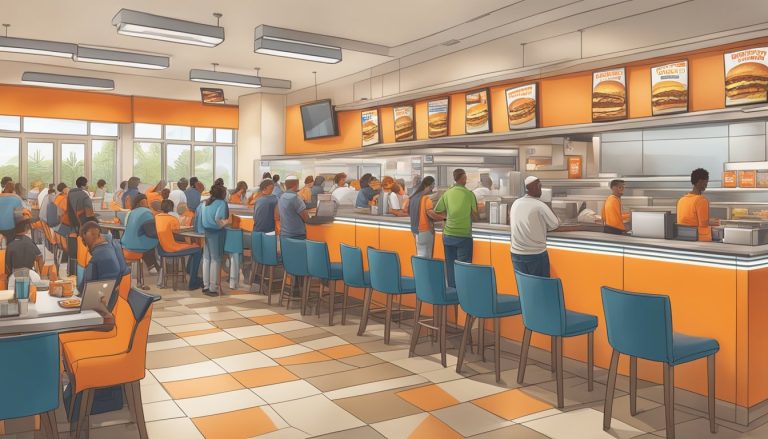Whataburger, the iconic Texas-based fast-food chain, has become an unexpected player in political campaigns across the Lone Star State. Its restaurants serve as informal hubs for political discussions and campaign stops, giving candidates a chance to connect with voters over a beloved local meal. Whataburger’s breakfast offerings, including the popular Breakfast Taquito, have become a staple for politicians seeking to establish their Texas credentials and appeal to the everyday voter.
The orange-and-white striped restaurants provide a familiar backdrop for campaign photo ops and informal meetings. Candidates from both major parties have been known to make Whataburger stops part of their campaign trail, often highlighting their breakfast orders on social media. This strategy allows politicians to align themselves with a cherished Texas brand and demonstrate their understanding of local culture.
While Whataburger itself maintains a neutral political stance, its breakfast menu has inadvertently become a tool for candidates to showcase their relatability. The chain’s role in political campaigns extends beyond mere dining, as it represents a shared cultural touchstone for many Texans. By incorporating Whataburger into their campaign activities, politicians tap into a sense of regional pride and create memorable moments that resonate with voters.
History of Whataburger

Whataburger’s journey from a small burger stand to a beloved Texas icon spans over seven decades. The company’s growth, expansion, and recent acquisition have shaped its position in the fast-food industry.
Establishment in Corpus Christi
Harmon Dobson founded Whataburger in 1950 in Corpus Christi, Texas. He opened a humble burger stand with a vision to create a burger so big it took two hands to hold. Dobson’s commitment to quality and large portions quickly gained popularity.
The first Whataburger sold for 25 cents and featured a quarter-pound beef patty on a 5-inch bun. This unique offering set Whataburger apart from competitors and laid the foundation for its future success.
Expansion and Growth
Whataburger’s expansion began in the 1960s with the introduction of its iconic A-frame restaurants. These distinctive orange-and-white structures stood three times taller than other burger stands, making them easily recognizable.
From 1961 to 1976, Whataburger built approximately 80 A-frame locations. The company’s growth extended beyond Texas, reaching other Southern states. By the 1970s, Whataburger had introduced its signature menu items, including the Whataburger Jr. and the Breakfast on a Bun.
Acquisition by BDT Capital Partners
In June 2019, the Dobson family sold its majority stake in Whataburger to BDT Capital Partners, a Chicago-based investment firm. This acquisition marked a significant change in the company’s ownership structure after nearly 70 years of family control.
Under new ownership, Whataburger has maintained its commitment to quality and Texas heritage. The company continues to expand, with plans to open new locations in various states. BDT Capital Partners aims to preserve Whataburger’s brand identity while driving growth and modernization efforts.
Whataburger as a Texas Icon

Whataburger has become deeply ingrained in Texas culture, transcending its role as a fast-food chain. Its distinctive branding and community ties have solidified its status as a beloved state icon.
Cultural Significance in Texas
Whataburger’s influence extends far beyond its menu offerings. In 2001, the Texas legislature officially designated Whataburger as a “Texas Treasure,” cementing its status as a cultural icon. This recognition highlights the chain’s importance to the state’s identity.
The restaurant’s popularity has made it a common reference point in Texas culture. Whataburger often features in local conversations, social media posts, and even political discourse. Its presence at high school football games and other community events further reinforces its cultural significance.
Whataburger’s menu, which incorporates regional flavors and Texas-sized portions, resonates strongly with Texans. This connection to local tastes has helped establish the chain as a true Texas institution.
Branding and Visual Identity
Whataburger’s distinctive orange-and-white striped buildings are instantly recognizable across Texas. The A-frame architecture, introduced in the 1960s, has become an iconic part of the Texas landscape.
The company’s visual identity extends beyond its buildings. Whataburger’s logo, packaging, and merchandise all feature the signature orange and white color scheme. This consistent branding has contributed significantly to the chain’s strong brand recognition and loyalty.
Whataburger’s visual elements have become so iconic that they often appear in Texas-themed art and merchandise, further solidifying the brand’s place in Texas culture.
Community and Cultural Ties
Whataburger actively cultivates strong community ties throughout Texas. The chain frequently partners with local sports teams, from high school to professional levels, strengthening its connection to Texas culture.
Many Texans have personal memories associated with Whataburger, from late-night visits after events to family dinners. These shared experiences contribute to the chain’s cultural importance.
Whataburger’s commitment to local communities extends to charitable initiatives and sponsorships of local events. This involvement reinforces the perception of Whataburger as more than just a restaurant, but a true part of the Texas community fabric.
Marketing and Branding Strategy

Whataburger’s marketing and branding efforts focus on quality, regional pride, and customer engagement. The company leverages various channels to build brand loyalty and connect with its audience.
Advertising Campaigns and Strategies
Whataburger’s advertising emphasizes its Texas roots and commitment to quality ingredients. The company utilizes a mix of traditional and digital media to reach customers. TV commercials often feature documentary-style ads highlighting the chain’s history and values. Radio spots and billboards reinforce brand messaging in local markets.
Print advertisements in regional publications target loyal customers. Whataburger’s signature orange-and-white color scheme is prominently featured across all marketing materials, reinforcing brand recognition.
The company’s “Just Like You Like It” slogan underscores its dedication to customization and customer satisfaction.
Social Media and Customer Engagement
Whataburger maintains an active social media presence across platforms like Facebook, Twitter, and Instagram. The company uses these channels to share promotions, respond to customer feedback, and foster community engagement.
User-generated content plays a key role in Whataburger’s social strategy. Fans are encouraged to share photos and stories, which are often featured on official accounts.
The brand’s witty and relatable social media posts have helped cultivate a loyal online following. Whataburger frequently engages in playful banter with competitors and participates in trending conversations, increasing brand visibility.
Online ordering and a mobile app enhance customer convenience and loyalty.
Whataburger’s Menu and Offerings

Whataburger’s menu boasts a diverse array of options, with a strong focus on breakfast items, signature burgers, and customizable choices. The chain’s commitment to quality ingredients and made-to-order preparation sets it apart in the fast-food landscape.
Breakfast Specialties
Whataburger’s breakfast menu has become a cornerstone of its offerings. The Honey Butter Chicken Biscuit stands out as a fan favorite, combining crispy chicken with sweet honey butter on a fluffy biscuit. Breakfast on a Bun provides a classic option with egg, cheese, and choice of bacon or sausage.
Breakfast taquitos offer a Tex-Mex twist, filled with scrambled eggs and various ingredients like cheese, potatoes, or bacon. These portable breakfast items cater to on-the-go customers and have gained popularity among early risers and night owls alike.
The chain serves breakfast from 11 p.m. to 11 a.m., accommodating diverse schedules and cravings.
Quality and Customization
Whataburger prides itself on using high-quality ingredients in all its menu items. The burgers feature 100% pure beef patties, cooked to order on a flat grill. Fresh produce and condiments complement each sandwich.
Customization is a key aspect of Whataburger’s appeal. Customers can modify their orders with various toppings, sauces, and bun options. This level of personalization extends to breakfast items and sides as well.
The drive-thru experience emphasizes accuracy and efficiency, ensuring that even customized orders are prepared correctly.
Signature Items and Menu Diversity
Beyond breakfast, Whataburger offers a range of signature items that have cemented its reputation. The Whataburger Jr. provides a smaller option for light eaters or children. The Whatachick’n Sandwich competes in the popular chicken sandwich market.
The Chop House Cheddar Burger showcases premium ingredients with its blend of grilled onions and melted cheddar. Spicy ketchup has become a cult favorite condiment, available both in-store and in retail locations.
The Honey BBQ Chicken Strip Sandwich combines crispy chicken strips with a tangy sauce, offering a unique flavor profile. These items, along with seasonal specialties, create a diverse menu that caters to various tastes and preferences.
Economic Dynamics

Whataburger’s economic influence extends beyond its menu offerings, shaping local economies and regional identities. The fast-food chain’s revenue streams and expansion strategies have contributed significantly to its economic impact across Texas and beyond.
Revenue and Economic Impact
Whataburger generates substantial revenue through its extensive network of restaurants. The chain’s 24-hour service model maximizes sales opportunities, catering to diverse customer schedules. This round-the-clock availability has become a key differentiator in the competitive fast-food landscape.
Whataburger’s economic footprint is particularly notable in Texas, where it originated. The company’s growth has led to job creation, both in restaurant operations and corporate roles. Local suppliers and vendors also benefit from Whataburger’s presence, creating a ripple effect in regional economies.
The brand’s strong Texas identity has transformed it into a cultural icon, attracting tourists and locals alike. This cultural significance translates into economic value, as Whataburger becomes a destination for out-of-state visitors seeking an authentic Texas experience.
Franchise Model and Expansion
Whataburger’s franchise model has been instrumental in its expansion beyond Texas. The company carefully selects franchisees who align with its values and quality standards. This approach ensures consistent customer experiences across locations while allowing for local market adaptations.
The expansion strategy focuses on contiguous growth, gradually moving into neighboring states. This measured approach helps maintain the brand’s regional appeal while tapping into new markets. Each new restaurant opening typically creates 60-120 jobs, contributing to local employment.
Whataburger’s expansion also involves strategic partnerships with local businesses and community organizations. These collaborations strengthen the brand’s presence in new areas and foster goodwill among residents. The company’s commitment to community engagement often translates into increased customer loyalty and positive word-of-mouth marketing.
Political Engagement

Whataburger’s breakfast offerings have become intertwined with political activities in Texas. The chain’s restaurants serve as informal meeting places for politicians and constituents alike. Its menu items feature prominently in campaign events and fundraisers.
Campaign Finance and Donations
Whataburger contributes to political campaigns on both sides of the aisle. In the 2024 election cycle, the company donated $18,553 to various candidates and causes. This bipartisan approach allows Whataburger to maintain relationships across the political spectrum.
The chain’s restaurants often host campaign events and informal gatherings. Politicians frequently make stops at Whataburger locations during their tours, using the familiar setting to connect with voters.
Local and state-level candidates have been known to purchase breakfast for their staff and volunteers from Whataburger. This practice supports both their campaigns and the local economy.
Influence on the Culinary Landscape
Whataburger’s breakfast menu has shaped Texas political culture in unique ways. The Breakfast Taquito, filled with eggs, cheese, and meat, has become a staple at early morning campaign meetings.
Politicians often reference Whataburger menu items in speeches and social media posts. This tactic helps them relate to constituents and showcase their Texas roots.
The chain’s kolaches, a nod to the state’s Czech heritage, demonstrate how Whataburger incorporates local culinary traditions. This cultural awareness strengthens its community ties and political relevance.
Whataburger’s breakfast offerings have influenced other restaurants in Texas. Many local eateries now offer similar items, creating a distinct breakfast culture in the state’s political circles.
Comparative Analysis

Whataburger’s breakfast offerings play a unique role in political campaigns, setting the Texas chain apart from national competitors. This analysis examines how Whataburger’s regional identity and menu options compare to other chains in the fast food landscape.
Whataburger Versus National Chains
Whataburger’s breakfast menu features distinctive items like the Honey Butter Chicken Biscuit, differentiating it from national chains. McDonald’s and Burger King offer more standardized breakfast options across the country.
Whataburger’s 24-hour service model allows politicians to engage with voters at any time, unlike many national chains with limited breakfast hours. This flexibility enhances its appeal for campaign stops and voter outreach events.
The Texas-based chain’s customization options surpass those of many national competitors. Politicians can tailor their orders to local preferences, demonstrating regional knowledge and connection.
Regional Versus National Identity
Whataburger’s strong Texas roots give it a powerful regional identity that resonates with local voters. National chains lack this deep connection to specific states or regions.
Politicians often use Whataburger as a symbol of Texas pride, incorporating it into campaign imagery and events. This strategy is less effective with national chains, which don’t carry the same cultural significance.
Whataburger’s merchandise, such as branded t-shirts and hats, serves as popular campaign giveaways. National chains’ merchandise typically lacks the same regional appeal and political utility.
The company’s localized marketing strategies align well with political campaigns focused on state or regional issues. National chains’ broad marketing approaches often fail to capture local nuances important in politics.
Future Prospects and Challenges

Whataburger faces exciting opportunities for expansion and growth, while also navigating the challenge of maintaining its unique Texas identity. The iconic chain aims to balance nationwide reach with regional appeal as it enters new markets.
Growth and Potential Acquisitions
Whataburger plans to expand beyond its current 15-state footprint in the coming years. The company is eyeing potential acquisitions of regional chains to accelerate growth.
New locations are slated to open in the Midwest and Southeast. Whataburger aims to reach 1,500 restaurants by 2030.
The chain is also investing in technology, including mobile ordering and delivery partnerships. This modernization effort seeks to attract younger customers.
Economic uncertainties may impact expansion plans. Rising food and labor costs could slow the pace of new store openings.
Maintaining Brand Identity Amidst Expansion
As Whataburger grows, preserving its Texas roots remains crucial. The company faces the challenge of appealing to new markets while retaining its core identity.
Regional menu items, like the Honey Butter Chicken Biscuit, may be adapted for different tastes. Whataburger is researching local flavors to incorporate into new markets.
The orange-and-white striped buildings will remain a brand hallmark. However, store designs may be tweaked to fit urban locations.
Whataburger’s 50th anniversary in 2050 will be a pivotal moment. The company aims to celebrate its heritage while positioning itself for future growth.




